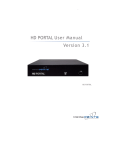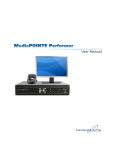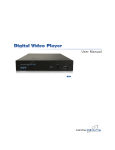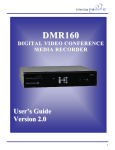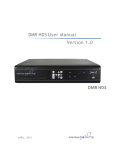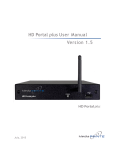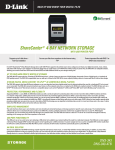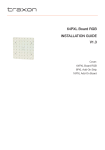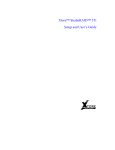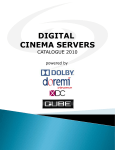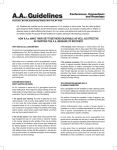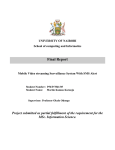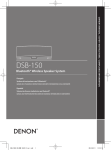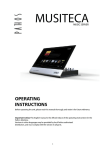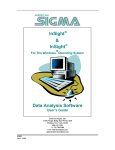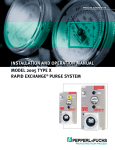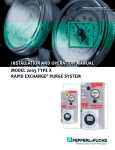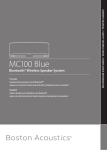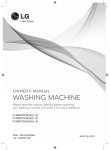Download Manual / User Guide
Transcript
Digital Media Recorder User Manual DMR An Advanced Media Design Technology DMR | Digital Media Recorder ©2009, Advanced Media Design, Inc All rights reserved. This document contains information that is proprietary to Advanced Media Design, the manufacturer of all MediaPOINTE® products. No part of this publication may be reproduced, stored in a retrieval system, or transmitted, in any form, or by any means, electronically, mechanically, by photocopying, or otherwise, without the prior written permission of Advanced Media Design, Inc. Nationally and internationally recognized trademarks and trade names are the property of their respective holders and are hereby acknowledged. MediaPOINTE® is a registered trademark of Advanced Media Design, Inc. Disclaimer The information in this document is believed to be accurate and reliable; however Advanced Media Design, Inc. assumes no responsibility or liability for any errors or inaccuracies that may appear in this document, nor for any infringements of patents or other rights of third parties resulting from its use. No license is granted under any patents or patent rights of Advanced Media Design, Inc. This document was written by the Development Department of Advanced Media Design, Inc. We are fully committed to, and take pride in maintaining high quality documentation. We welcome and appreciate any comments or suggestions you may have regarding content, presentation, structure and distribution of this document. Please use the contact information below for all correspondence: Development Department Advanced Media Design, Inc. 667 Rancho Conejo Blvd. Newbury Park, CA 91320 USA [email protected] Version 4.0 ii | DMR User Manual 4.0 August 2009 Safety Precautions For your protection, please read all related safety instructions, observe all warnings and precautions, and exercise common sense while operating this electronic equipment. • Always place the unit on a stable cart, stand or table. • Do not use the unit near water or sources of heat. • Do not drop or shake the unit. Do not place or install the unit in environments where it can be dropped or shaken. Make sure the unit is powered off while being moved even for short distances. • Observe the power requirements of the unit; if you are not sure of the power available, consult your local dealer or power company. • When plugging into a power outlet, insert the plug firmly into the outlet. Route the power cord so as to avoid any activity that may result in fraying or other damage to the cord or the plug. • Under no circumstances should you attempt to override the polarization or grounding protection on the plug. • Do not overload wall outlets, integral convenience receptacles or extension cords. • Unplug the unit from the wall before cleaning. Do not use liquid or aerosol cleaners. • For proper ventilation, do not block the slots and openings. Do not install the unit in a location where the ventilation slots and openings can be plugged during everyday use. • Do not place or install the unit under, on top of or near any heat-producing equipment (i.e. radiators, stoves, or amplifiers), or in a heated place. • Unplug the unit during lightning storms, when it will not be used for extended periods of time, or before you have a scheduled power outage. If the unit is visibly damaged either by not observing the precautions above or for any other reason, contact your local dealer immediately. If the unit does not operate to the specifications set forth in this user guide, or exhibits a distinct change in performance, this may be an indication of a problem needing repair. Environmental Operating Limits of DMR Operating Temperature: 0°C to 32°C (32°F to 90°F) Relative Humidity: 10% to 90% non-condensing Storage & Transport Temperature: -20°C to 80°C (-4°F to 140° F) Electrical requirements Input: 100-240V ~50/60Hz Service Support and Training MediaPOINTE®, Inc. is committed to providing the service support and training needed to install, manage, and maintain your MediaPOINTE® equipment. All MediaPOINTE® products are sold through a wide network of Authorized MediaPOINTE® Dealers. For help with your products, contact your local dealer for assistance first. If for any reason, you would like to contact MediaPOINTE® directly for information regarding service programs and extended warranty information, training, installation or usage, we are glad to be of assistance. You can contact us at the phone number listed below, or visit our website. MediaPOINTE® Technical Support Hours: 8:30 a.m. – 5:30 p.m. Pacific Standard Time (866) 709-0444 TOLL FREE (805) 214-7911 INTERNATIONAL [email protected] DMR | iii DMR Package Contents • 1 - MediaPOINTE DMR • 1 – Male Composite Cable • 1 - CAT-5e LAN Cable • 1 - RCA Stereo Audio Cable • 1 - AC Power Cable • 1 – Male S-Video-D Cable • 1 – IR Remote Control plus 2 AAA batteries • 1 – Rack Mount Kit • Documentation CD-ROM • Warranty Document • Registration Sheet iv | DMR User Manual 4.0 August 2009 Warranty MediaPOINTE warrants that the DMR (excluding spare parts if applicable, external peripheral devices and consumables) will be free from any defect in materials or workmanship and shall perform in accordance with its specification for a period of 30 days for MediaPOINTE software and 1 year for hardware, starting on shipment date of the initial purchase of the equipment. MediaPOINTE disclaims any and all implied warranties of merchantability or fitness for a particular purpose. MediaPOINTE’s sole liability for breach of this warranty will be (at its option) to provide access to software for download or to repair or replace the defective unit or component after customer has shipped the product to MediaPOINTE for return-to-factory repair. Customer must obtain an RMA (return material authorization) number from MediaPOINTE prior to returning equipment. Replacement parts may be new or equivalent to new. Part(s) replaced will be covered for the remaining term of the warranty. MediaPOINTE shall not be liable for any loss of profits or incidental or consequential loss for whatever reason. This warranty will be void if the equipment has been subject to any unauthorized modifications, improper operation, user negligence, service by an unauthorized person, accident, neglect, misuse, tampering, acts of God, or any event other than ordinary use. Document Conventions The following conventions are used throughout this user’s guide. The hand symbol indicates a note, containing special instructions, and in some cases, circumstances that require caution. The light bulb symbol highlights suggestions or hints. The high voltage symbol is intended to alert the user to the presence of un-insulated, dangerous voltages. Table of contents | Table Of Contents About this guide Disclaimer. . . . . . . . . . . . . . . . . . . . . . . . . . . . . . . . i Safety Precautions. . . . . . . . . . . . . . . . . . . . . . . . . . . . . ii Services & Support . . . . . . . . . . . . . . . . . . . . . . . . . . . . ii Package Contents . . . . . . . . . . . . . . . . . . . . . . . . . . . . iii Warranty. . . . . . . . . . . . . . . . . . . . . . . . . . . . . . . . iv Document Conventions . . . . . . . . . . . . . . . . . . . . . . . . . . iv 1 Introduction, Overview & Requirements Introduction . . . . . . . . . . . . . . . . . . . . . . . . . . . . . . . . . 1 Key Features. . . . . . . . . . . . . . . . . . . . . . . . . . . . . . . 1 How It works. . . . . . . . . . . . . . . . . . . . . . . . . . . . . . . 1 Front Panel . . . . . . . . . . . . . . . . . . . . . . . . . . . . . . . . . 2 Optical Drive. . . . . . . . . . . . . . . . . . . . . . . . . . . . . . . 2 Front Keypad. . . . . . . . . . . . . . . . . . . . . . . . . . . . . . . 2 LED Status. . . . . . . . . . . . . . . . . . . . . . . . . . . . . . . . 2 IR Receiver. . . . . . . . . . . . . . . . . . . . . . . . . . . . . . . . 2 Reset Button . . . . . . . . . . . . . . . . . . . . . . . . . . . . . . . 2 Power Switch. . . . . . . . . . . . . . . . . . . . . . . . . . . . . . . 3 USB Port. . . . . . . . . . . . . . . . . . . . . . . . . . . . . . . . . 3 Back Panel . . . . . . . . . . . . . . . . . . . . . . . . . . . . . . . . . . 4 Inputs/Outputs. . . . . . . . . . . . . . . . . . . . . . . . . . . . . . 4 Setup & Application Diagrams . . . . . . . . . . . . . . . . . . . . . . . . . 5 2 Setting Up the DMR 8 Logging In. . . . . . . . . . . . . . . . . . . . . . . . . . . . . . . . . . 8 Web Portal Access . . . . . . . . . . . . . . . . . . . . . . . . . . . . . 8 As an Administrator. . . . . . . . . . . . . . . . . . . . . . . . . . . . 8 Changing Administrator Password. . . . . . . . . . . . . . . . . . . . . 8 vi | TABLE OF CONTENTS As a User . . . . . . . . . . . . . . . . . . . . . . . . . . . . . . . . . 9 User Login Security. . . . . . . . . . . . . . . . . . . . . . . . . . . . 9 As an Author . . . . . . . . . . . . . . . . . . . . . . . . . . . . . . . 9 Date & Time. . . . . . . . . . . . . . . . . . . . . . . . . . . . . . . 9 Network Configuration. . . . . . . . . . . . . . . . . . . . . . . . . . 10 System Name. . . . . . . . . . . . . . . . . . . . . . . . . . . . . . 10 IP Settings . . . . . . . . . . . . . . . . . . . . . . . . . . . . . . . 10 Configuring Static IP Address . . . . . . . . . . . . . . . . . . . . . . . 10 Configuring DHCP IP Address . . . . . . . . . . . . . . . . . . . . . . . 10 USB Network Configuration. . . . . . . . . . . . . . . . . . . . . . . . . . 10 SMTP Mail. . . . . . . . . . . . . . . . . . . . . . . . . . . . . . . . 11 Command Line . . . . . . . . . . . . . . . . . . . . . . . . . . . . . 11 Telnet (TCP/IP). . . . . . . . . . . . . . . . . . . . . . . . . . . . . . 11 RS-232. . . . . . . . . . . . . . . . . . . . . . . . . . . . . . . . . 11 3 Control & Operation Web Portal. . . . . . . . . . . . . . . . . . . . . . . . . . . . . . . . . 12 Overview. . . . . . . . . . . . . . . . . . . . . . . . . . . . . . . . . . 12 Toolbar . . . . . . . . . . . . . . . . . . . . . . . . . . . . . . . . . 12 Folder Management Table . . . . . . . . . . . . . . . . . . . . . . . . 12 On-Screen Menu/ Front Control Panel. . . . . . . . . . . . . . . . . . . 13 External Control. . . . . . . . . . . . . . . . . . . . . . . . . . . . . . . 13 RS-232. . . . . . . . . . . . . . . . . . . . . . . . . . . . . . . . . 13 Telnet. . . . . . . . . . . . . . . . . . . . . . . . . . . . . . . . . . 14 Infra-Red. . . . . . . . . . . . . . . . . . . . . . . . . . . . . . . . 14 Remote Contact Closure (relay) . . . . . . . . . . . . . . . . . . . . . . 14 4 Recording, Archiving & Streaming Recording & Streaming. . . . . . . . . . . . . . . . . . . . . . . . . . . . 15 Changing Profiles. . . . . . . . . . . . . . . . . . . . . . . . . . . . . . 15 Recorded Content Detail. . . . . . . . . . . . . . . . . . . . . . . . . . . 16 Playback on DMR. . . . . . . . . . . . . . . . . . . . . . . . . . . . . . 16 Archiving. . . . . . . . . . . . . . . . . . . . . . . . . . . . . . . . . . 16 Mail Attachment . . . . . . . . . . . . . . . . . . . . . . . . . . . . . 16 Download Manager. . . . . . . . . . . . . . . . . . . . . . . . . . . 17 Disk Burning. . . . . . . . . . . . . . . . . . . . . . . . . . . . . . . 17 Table of contents | vii USB Offload/Upload . . . . . . . . . . . . . . . . . . . . . . . . . . . 17 Streaming. . . . . . . . . . . . . . . . . . . . . . . . . . . . . . . . 17 Manual FTP Upload . . . . . . . . . . . . . . . . . . . . . . . . . . . 17 Metadata. . . . . . . . . . . . . . . . . . . . . . . . . . . . . . . . 17 Transcoding. . . . . . . . . . . . . . . . . . . . . . . . . . . . . . . 17 5 Management & System Tools 5 Profiles . . . . . . . . . . . . . . . . . . . . . . . . . . . . . . . . . . . 18 Profile List. . . . . . . . . . . . . . . . . . . . . . . . . . . . . . . . 18 Creating/Modifying a Profile. . . . . . . . . . . . . . . . . . . . . . . 19 Capture Settings. . . . . . . . . . . . . . . . . . . . . . . . . . . . . 19 Stream Settings. . . . . . . . . . . . . . . . . . . . . . . . . . . . . 19 Archive & Custom Settings. . . . . . . . . . . . . . . . . . . . . . . . 19 Titles & Credits. . . . . . . . . . . . . . . . . . . . . . . . . . . . . . . 20 AV Controls . . . . . . . . . . . . . . . . . . . . . . . . . . . . . . . . . 20 Display Settings. . . . . . . . . . . . . . . . . . . . . . . . . . . . . 20 AV Test . . . . . . . . . . . . . . . . . . . . . . . . . . . . . . . . . . . 20 Live Video Test. . . . . . . . . . . . . . . . . . . . . . . . . . . . . . . . 20 Notifications. . . . . . . . . . . . . . . . . . . . . . . . . . . . . . . . 21 Storage Limits. . . . . . . . . . . . . . . . . . . . . . . . . . . . . . . . 21 Logging . . . . . . . . . . . . . . . . . . . . . . . . . . . . . . . . . . 21 Update. . . . . . . . . . . . . . . . . . . . . . . . . . . . . . . . . . . 21 Upgrade System Software. . . . . . . . . . . . . . . . . . . . . . . . . . 21 Reset Configuration. . . . . . . . . . . . . . . . . . . . . . . . . . . . . 22 System Info. . . . . . . . . . . . . . . . . . . . . . . . . . . . . . . . . 22 Shutdown . . . . . . . . . . . . . . . . . . . . . . . . . . . . . . . . . 22 Reboot. . . . . . . . . . . . . . . . . . . . . . . . . . . . . . . . . . . 22 6 Options Installing Package Upgrades . . . . . . . . . . . . . . . . . . . . . . . . . 23 Studio Package. . . . . . . . . . . . . . . . . . . . . . . . . . . . . . . 23 Video Source Inputs. . . . . . . . . . . . . . . . . . . . . . . . . . . 23 Custom Video Templates. . . . . . . . . . . . . . . . . . . . . . . . . 23 Video-On-Demand Option. . . . . . . . . . . . . . . . . . . . . . . . . . 24 Viewing a Video-On-Demand Channel . . . . . . . . . . . . . . . . . . . 24 AESOP External Storage Option . . . . . . . . . . . . . . . . . . . . . . 24 Blu-Ray Hardware Upgrade Option. . . . . . . . . . . . . . . . . . . . . 24 1 DMR | DMR Introduction & Overview Introduction design, or process analysis when the participants are not able to meet in one central location. Welcome to the user’s guide for the MediaPOINTE® DMR. The DMR is one of the easiest to use, costeffective and reliable archiving and streaming products on the market today. It can archive important audio, video, and graphical data while simultaneously transmitting it anywhere on your network. • Access a centralized data bank of expertise from a field location. This user’s guide describes how to set up and use the DMR to record and transport graphics, video and audio content over IP networks. As with all MediaPOINTE AVover-IP products, you can control the DMR by different methods. These methods include: Web Portal interface, remote control, contact closure, RS-232 serial port, Telnet, or from the convenient front keypad. How It Works (Method of Operation) The DMR can archive and stream video and audio media. The DMR accepts S-Video, composite video, and unbalanced line level stereo audio inputs. The selected input source along with the associated audio is captured into a file which can be simultaneously streamed live over your network during the archival process. This guide is written for units running 4.0 software. If your DMR is operating on a different version of software, some capabilities and screenshots may be different. Users can select from several configurable parameters (profiles) for capturing and subsequent playback of the recorded material. These profiles are fully configurable, allowing the user to specify the input source, capture resolution, bit and frame rates. Key Features The archived recordings are stored on the DMR’s hard drive. The recorded file can then be viewed on your PC or replayed directly from the DMR on a local monitor. The content can also be copied to a USB memory stick, burned to DVD-R, DVD+R or CD-R disk, downloaded to a PC, attached to an e-mail, or automatically transferred (FTP) to a server after the file has been indexed. The DMR may be used in a variety of situations for live communication and collaboration, including: • Archive media content from multiple independent sources. • Share visual information, designs, and concepts with dispersed groups of people to gather input during a video conference. • Stream important videoconferences to other locations such as overflow rooms or remote conference locations over your corporate network. • Conduct customer or employee training across vast geographical areas. • Discuss research, engineering, architecture, product The DMR records content in standard MPEG-4 ASP, which can be played on a variety of desktop client players including QuickTime. It can record content in Windows Media Format that can be played in Windows Media Player. | DMR User Manual 4.0 August 2009 DMR Front Panel 1 2 3 4 5 6 7 Front Panel View 3. LED Status The front panel consists of an Optical Drive, the main operation Keypad, two status LEDs, a small RESET button, IR receiver, a power switch and a USB port. The following is a brief description of each of these components. The LED indicators are used to describe system states, actions and error conditions. The valid LED states are described in the table below. LED 1 (top) LED 2 (bottom) RED/YELLOW/ ORANGE BLUE 1. Optical Drive Powering On Orange OFF The DMR features an optical drive capable of recording to DVD-R, DVD+R, and CD-R media. Ready OFF ON Record/Stream RED ON Indexing RED Fast Blink ON Play/ OFF Slow Blink Error YELLOW Fast Blink OFF Disk Burn RED Slow Blink ON Mute (not record) OFF Fast Blink Mute (record) RED Fast Blink 2. Front Keypad The DMR has a front keypad that allows the user to start and stop recording as well as navigate the on screen menus without using the remote control. When the REC button is pressed a menu will appear on the display so you can determine which recording profile to use. A monitor is required to use this feature. 4. RESET Button To avoid inadvertent resetting of the system, the RESET button is hidden behind a tiny hole in the front panel and requires activation using a small device such as a pin or paperclip. Pressing the RESET button will reset the Administrator Password and return the IP settings back to the default network settings. 5. IR Receiver The IR Receiver is used with the included remote control. DMR | DMR Front Panel 1 2 6. Power Switch This POWER button on the front of the unit will turn the unit on and off. It is used in conjunction with the main power switch on the rear of the unit. 1. Ensure power supply switch is in the ON position (on back panel) 2. Start the unit by pressing the POWER button 7. USB Port The USB port can be used to offload media from and to the DMR. It can also be used to set or capture an IP address. See the Network Configuration section for USB IP address configuration. 3 4 5 6 7 | DMR User Manual 4.0 August 2009 Back Panel View 8 7 10 9 1 2 3 4 5 6 11 AUDIO/ VIDEO INPUTS Connector Function Description Unbalanced Line level stereo audio inputs that use standard RCA connectors. 1 Stereo Audio Pair Composite Video input 1 on the DMR can be selected from the Web Portal. 2 Composite S-Video input 1 on the DMR can be selected from the Web Portal. 3 S-Video AUDIO/ VIDEO OUTPUTS Connector Function Description Unbalanced Line level stereo audio outputs that use standard RCA connectors. 4 Stereo Audio Pair 5 Composite 6 S-Video DMR | ALL OTHER CONNECTIONS Connector 7 8 Function LAN Remote Relay Closure 9 USB 10 RS-232 11 AC Power Setup & Application Diagrams Description The RJ45 connector allows the included standard 10/100Mb CAT-5e LAN cable to connect the DMR to a network. The standard 3.5 mini mono connector allows a remote switch (contact closure) to start/stop a session of the DMR. The USB port on the back of the unit can be used for upload or offload of video content and for network configuration of the DMR. For more information on USB network configuration, see Appendix B. This standard serial DB9 connector allows connection for serial control (note: a null-modem serial cable is required). The IEC connector allows the included IEC cable to connect the DMR to AC power. Make sure the power on/off switch is in the off position before plugging in the power cable. | DMR User Manual 4.0 August 2009 DMR | | DMR User Manual 4.0 2 August 2009 Setting Up the DMR Setup Use this information when you are ready to install the DMR hardware at your site. To turn on the unit ensure the power supply switch is in thewhen ON position start the unit Use this information you firstthen purchase DMR by and pressing when youthe arePOWER ready button. to install the hardware at your site. This section shows the back panel and explains how to connect the separate input connections to the unit. Logging In This section describes the procedure for a first time login, and the DMR access rights. The default IP address is: 192.168.1.253 As an Administrator The Administrator maintains all rights to the DMR. 1. If you are already logged into the DMR as a user or author, click on the LOG out selection at the top right of the web UI. You will be able to enter a username and password. 2. Use the login id “admin”. The default password is “MediaPOINTE”. Note that the login id and the password are case sensitive. 3. From the User Security selection of the main menu, the Administrator can enable or disable logins for users and authors and can change the admin password. Web Portal Access: To log into the DMR, browse to its IP address using your Internet browser. There are three levels of access rights. There is a “user” login, an “author” login, and a system “admin” login. Changing the Administrator Password Administrator rights are required to access or change any of the settings under the “Configure” and “Manage” sections in the main menu. By default, the Administrator ID and password are set to “admin” and “MediaPOINTE” respectively. It is not possible to change the Administrator ID. It will always be “admin”. To change the Administrator password, enter a new Administrator password in the “New admin Password” field (10 characters maximum) and confirm it by clicking Change Admin Password button. The next time the DMR is accessed, the new admin password will take effect. Be sure to write down the new administrator password and keep it in a safe place. If you forget the admin password, the DMR will have to be reset back to the factory defaults to enable an administrator to access the “Configure” and “Manage” sections of the unit. As a User Once you have navigated to the site, you will be presented with the login page. Administrative login is required to make changes to the system settings under the “Configure” and “Manage” sections of the menu. If content playback is all you require from the DMR, you will not need administrator rights. No password is required for the standard Guest user login as a default. The administrator has the ability to modify this feature to require a password for viewers to login. To change the default IP settings of the DMR or any of the other configuration settings, you must log in with administrator rights. User Login Security By default, user security is turned off. Anyone can LOGIN to the DMR without being asked for a login ID or password. Check the Enable user security checkbox to enable security for the user. This will require all users to have an ID of “user” and the password created in the “user password” field. Enter a user password in the “user password” field and confirm it by clicking the Save user Security Settings button. The next time the DMR is accessed, anyone logging in will be presented with a login box asking for the ID “user” and a password. Un-checking the Enable user security checkbox will restore the default settings. As an Author The Author maintains content creation rights on the DMR. The Author can set recording options but does not have access to the “Configure” and “Manage” sections of the menu. 1. If you are already logged into the DMR as a user or admin, click on the LOGOUT selection at the top of the main menu. You will be prompted to enter a username and password. DMR | 2. Use the login id “author”. The password will be user defined in the User Security section of the main menu. Note that the login id and the password are case sensitive. Author Login Security Author rights are required to access or change any of the settings under the “Options” section in the main menu. By default, the author login password is disabled. Checking the Enable author checkbox will enable the author login security. Enter an author password in the “author password” field and confirm it by clicking save author Security Settings button. Un-checking the Enable author LOGIN checkbox will deactivate the need for an author login password Date & Time When content is recorded using the DMR it is given a time and date stamp. The time and date stamp can be set in the Date & Time section of the main menu. The date can be selected from the pop-up calendar. Confirm any changes by clicking on the Set Date & Time button. If desired, the NTP (Network Time Protocol) feature can be enabled to synchronize the clock of the DMR to an NTP server; click on the “Enable NTP” box and enter the server information, then click on Save NTP settings. 10 | DMR User Manual 4.0 August 2009 Network Configuration System Name The factory set system name is the unit build number. You can change the name in the IP setting menu page by entering a new name in the text field. A reboot is required for the new name to take effect. The name can be up to 15 characters long and consist of alphanumeric characters. No special characters or symbols will be accepted except for a hyphen. IP addresses may be assigned to the DMR by two ways: DHCP and Fixed (Static) IP. If your network is configured for DHCP, the IP address will be provided automatically and will be visible on the S-Video or Composite output of the DMR. To set a Fixed (Static) IP address, follow the procedure below. Configuring Static IP Address 1. Connect the Ethernet / LAN cable and power up the DMR. 2. On your Internet browser, enter the current IP address of the DMR. (Note: If the unit has factory settings, the default static IP address is: 192.168.1.253) 3.Login to the DMR using the procedure shown in the Logging In section. 4. Navigate to the network settings page by selecting IP Settings. 5. To change to a Fixed or Static IP address, set the DHCP Client checkbox to “Disable”. Fill in the IP Address, IP Subnet Mask and Default Gateway fields. IP Settings The System Name and all network settings can be set in the IP Settings section of the main menu. Network settings may also be configured via USB memory stick configuration. To quickly find the system’s IP Address, connect a Composite or S-Video monitor to the output. Use the keypad to navigate to the System Info page of the on screen menu. Network Configuration Setting Description DHCP Client Enable DHCP settings for automatic address retrieval f rom DHCP Server. Disabling the DHCP client will require a static IP address (with subnet mask and default gateway) to be entered. IP Address Assign a static IP address to DMR. This field will also display the currently assigned IP address IP Subnet Mask Assign subnet mask to DMR. This field will also display the currently assigned subnet mask Default gateway Assign a default gateway to the DMR. This field will also display the currenty assigned default gateway DNS server If the network supports DNS, enter the DNS Server Address(es) here. 6. Once you have completed all of the above steps, select the Apply Changes button. You will receive a popup window warning you to use this option with caution as you are changing the default address and should remember the new settings. Configuring DHCP IP Address 1. Follow the steps above (1 through 4) 2. To enable the DMR to pick up an IP address, set the DHCP Client checkbox to “Enable”. 3. If you have made any changes to the network settings, select the Apply Changes button. You will receive a pop-up window warning you that you to use this option with caution as you are changing the default address and should remember the new settings. USB Network Configuration This section describes how to configure the DMR. Changes in the Configure section of the Main Menu require Administrator privileges and cannot be accessed by users logged in with author or user profiles. The network parameters of the DMR can be set via a special configuration text file on a USB memory stick. Insert the memory stick into one of the DMR USB ports at any time. The unit will look for the presence of this configuration file and will implement the settings from the file. Use a simple ASCII text editor to create the file. DMR | 11 dhcp=(bool)0 dns_1=(string)192.168.0.2 dns_2=(string) 192.168.0.3 ethernet=(string)auto gateway=(string)192.168.1.1 ipaddress=(string)192.168.1.253 netmask=(string)255.255.255.0 If the dmx_ip_conf.txt file is intentionally left blank with no text of any type within the body of the file, the DMR will write its network settings to this file. This is an easy way to obtain the unit’s network settings. SMTP Mail The DMR has the ability to send email messages to a remote SMTP server. Enter the address of the SMTP server in the appropriate text box (use the IP address if DNS settings are not set). The Email field will set the default “From” field to the entered email. Leave this field blank to allow the user to enter their own “From” email address. Confirm any changes to the SMTP mail configuration by clicking Save SMTP settings button. Command Line The DMR has a Command Line interface that can be accessed from Telnet or RS-232. A list of commands can be found in the External Control section of this manual. Telnet (TCP/IP) The Telnet port by default is not enabled. To turn on Telnet control, set the Telnet port number (typically Port 23) and check the TCP/IP port enable checkbox. A password for the Telnet session can be activated by entering a password in the Password for TCP/IP connection text box. If a password is not desired on the Telnet session, leave the text box blank. RS-232 On the back of the DMR there is a serial control port configured as a DTE that supports the RS-232 protocol. A Null-Modem cable should be used between the DMR and the COM port on your PC. Terminal session settings required for RS-232 control are: 9600, 8, None, 1 with No Flow Control. There is no password protection on this interface and, by default the RS-232 port is enabled. The administrator has the ability to disable the port by unchecking the COM port enable checkbox. 12 | DMR User Manual 4.0 3 August 2009 Control & Operationud ea Toolbar The DMR can be controlled by several different methods. These include, a Web Portal interface, IR remote control, contact closure, RS-232 serial port, Telnet, or by the convenient button panel (Keypad) on the front of the unit. This section will cover each of these control interfaces in detail. Web Portal Overview The DMR has a fully featured Web Portal that can be accessed via a web browser. Enter the unit’s IP address in the web browser’s address bar and complete a log on. From this screen you can start and stop a recording session, play or download previously archived material, set recording preferences and move content off/on or within the DMR. Selecting the Watch Videos selection from the main menu will show a list of all current recordings in the Root directory. Icon Function Create New Folder Rename Folder Delete Folder Folder Password Open All Folders Close All Folders Toolbar When logged in as either author or admin selecting the Archives selection from the main menu will provide the main system Toolbar. Description Will create a new folder without password protection. Will allow the user to change the name of the selected folder. This will permanently delete a folder; including all content held within. This icon will allow the user to password protect the currently selected folder. If the folder is already password protected, it will allow the user to change the password. Will show all folders on the DMR. Will show only the highest tier folder of the folder tree. Close Folder View Will hide all folders on the DMR. ROOT Directory Is the highest level directory/folder that content can be stored in. Password Protected Folder A folder that has been password protected will be displayed with the lock icon. DMR | 13 On-Screen Menu / Front Control Panel The On-Screen Menu is displayed on the Composite or S-Video output of the DMR. The DMR IR remote or Front Control Panel (keypad) will provide some of the configuration features of the Web Portal as well as provide the ability to navigate and playback nonpassword protected content stored on the DMR. Icon Function Description Show Folders Will display the folder management tree. Move to Will allow content to be moved from one folder to another. Copy to Will allow a copy of a media file to be created in a different folder. Delete Selected Will delete the selected content. There is no recycle bin or recovery process for content that has been deleted. Currently the on screen menus give the user the following capabilities: ♦ Start/Stop Recording ♦ Browse and Play non-password protected content ♦ Browse and Play recent content ♦ Burn content to optical disk ♦ Copy content to USB ♦ Display test images and tones Mail Attachement Manager Will open the Mail Attachment Manager to allow content to be emailed. ♦ Set audio input recording level ♦ Adjust the Menu opacity, position and timeout Download to my PC Will open the Download Manager to allow content to be moved to the local PC. ♦ Retrieve System Information Show DVD Will open the Disk Manager to allow content to be burned to a DVD-R, DVD+R or CD-R. Eject DVD Will eject DVD from DVD drive External Control RS-232 DB-9 Female Function DB-9 Female 2 Rx to Tx 3 3 Tx to Rx 2 5 Signal Ground 5 On the back of the DMR there is a single control port configured as a DTE that supports the RS-232 protocol. A Null-Modem cable should be used between the DMR 14 | DMR User Manual 4.0 August 2009 and the COM port on your PC – the pinout is shown here. Terminal session settings required for RS-232 control are: 9600, 8, None, 1 with No Flow Control. Infra-Red The Infra-Red (IR) receiver for the remote control is located on the front of the DMR. It can also be used for IR control via control systems such as AMX or Crestron. Remote Contact Closure (Relay) audiogain help or ? multicast shutdown author input multicast_ttl smtp bye/quit ipassign notify status cli ipset play sysinfo copyme ipstat playstatus test defaultprofile key reboot usersec displayres limit record volume displayratio listfiles rename file info list profiles resetconf There is no password protection on this interface and, by default, the RS-232 port is enabled. However, the administrator has the ability to disable the serial control port from the Web Portal. See below for a list of the available commands. For more information on external control, please refer to the MediaPOINTE Command Line Interface document. Telnet The telnet client within the DMR provides access to the Command Line Interface through the TCP/IP protocol. By default, telnet is disabled but can be activated from the Web Portal with an optional password. The available commands are the same as listed in the RS232 section. To access the telnet client, open a command prompt on your computer and enter: telnet <ipaddress> Once connected to the DMR, a connect message will be displayed. DMR Welcome to MediaPOINTE Password:_ Once logged in, type ‘help’ or ‘?’ for a list of commands. A relay contact closure connection is mounted on the back as a 1/8th (3.5mm) phone plug. Either a mono or stereo plug can be used, but in the case of the stereo phone plug, short the sleeve to the ring as the negative connection. This connection can be wired to a simple switch closure and will start or stop a recording. Note: There is a +5V on the tip This closure can be in the form of a relay, manual switch or semi-conductor switch. This allows for relay control via external control systems such as AMX, Crestron, or by a plain momentary trigger, such as a footswitch. Semi-conductor closures are found on AMX or Crestron controllers in the form of a D I/O port. If using a semiconductor closure, polarity is important. The phone plug tip must be wired to the + or individual input of the D I/O port, and the sleeve connected to the ground or - connector. Note that, unlike relay connections, these connections are not isolated and can form grounding or hum loops. DMR | 15 4 Recording, Archiving & Streaming Recording and Streaming A streaming/recording session can be started and stopped from the Start/Stop section of the main toolbar and from the profile listing. The “default” profile will be used unless another profile is selected. To select an alternate profile, use the Change button to bring up a profile listing. busy and cannot record or stream until the process is complete. Depending on the length of the archived material, this could take a few seconds up to several minutes to complete. Disabling / enabling multicast By default the DMR will multicast anytime a profile is intiated with streaming enabled. Multicast can be disabled so only unicast streams will be supplied. To disable multicast, access the CLI and enter the “multicast off” command. Changing Profiles On the Start/Stop page, you can click on the Change icon and you will get a list pop-up with all available profiles. Select on the profile of your choice and the Start/Stop page will automatically be updated. The RED LED will illuminate when the DMR is recording/ streaming and the Web Portal will display a “Recording” message at the top of the page. The record/stream parameters will be as specified in the profile that was chosen. To stop the recording and create an archived file, press the Stop button to begin the “indexing” process. The RED LED on the front of the unit will blink fast during the indexing procedure, indicating that the unit is Content Detail 16 | DMR User Manual 4.0 August 2009 Recorded Content Detail Icon Function Rename Description Will allow the user to change the name of the selected folder. Email Media Will allow the selected file(s) to be emailed. This feature will not be available if SMTP settings are not enabled. Stream Will play media on local PC that is browsing DMR. The media will playback within the web portal using an MPEG-4 capable playback plug-in (such as Quicktime) DVD Playback To watch a DVD on the DMR, insert the DVD into the DVD drive. The movie will begin to play. Use the remote control to control the playback of the DVD. Archiving Mail Attachment Once you have enabled the SMTP Mail settings you will have the ability to attach the file to an email. Will allow the selected file to be downloaded to Download to the local PC. A pop-up dialog box will ask for a my PC file location and name for saved file Play on DMR Will start the media playback on the Composite and S-Video output simultaneously. ROOT Directory Is the highest level directory/folder that content can be stored in. Password Protected Folder A folder that has been password protected will be displayed with the lock icon. Upload to Server Transfer a file to a remote server. Icon Function Transcode Convert the MPEG-4 File to WMV, H.264, and iPod formats. Attach to Mail Metadata Tag a video file with information such as Author, Title, Keywords and more. Add Folder Description Will attach the selected content to an email. Will add the selected folder to the email attachment. Will remove the selected folder from the Remove Folder email attachment. Add Media Will add the selected media to the email attachment. Will remove the selected media from the Remove Media email attachment. Playback on DMR Content stored on the DMR can be viewed on the Composite or S-Video output. Selecting the Play Locally button will start the content playback. During playback, the pause, stop, skip forward and skip backward controls will be provided. To play content on the local PC that is browsing the DMR click on the Play button. In order to play the file, an MPEG-4 capable playback application (such as Quicktime Player) is required on the viewing PC. Will close the Mail Attachment Window. Close Mail Default Folder A recording initiated from IR, the remote relay closure or the REC button will be saved to the BLUE Default Folder DMR | 17 Download Manager Files and Folders can be downloaded to the browsing computer using the Download Manager. Select the Download Manager icon from the main menu to bring up the Download Manager Toolbar. server. SCP, FTP, and FTPS are all available options for transferring files. To transfer your desired file, choose the Manual FTP icon in the actions menu. Enter the server destination, Port number (optional for non standard ports), Destination path, and credentials. You can choose to delete the content after a successful upload. Metadata Metadata tagging allows you to tag a video file with information such as Author, Title, Keywords and more. This information is stored in the header of the Video file. A second copy of this information is stored within an XML file that is downloaded or transferred alongside the file. To add metadata to the file, select the video you wish to edit and click on the metadata icon in the Actions Menu associated with that file. Then enter your desired information into the available fields. Disk Burning The disks are burned as Data Disk. Content can be moved from the DMR to an optical disk. Insert a blank disk into the DMR and select the Disk icon from the main menu. This will display the Toolbar that will provide icons for burning media files and folders to the optical drive. Formats supported include DVD-R, DVD+R and CD-R. USB Offload / Upload The front USB port can be used to move media to or from the DMR. Connect the USB memory stick and a folder named USB will appear in the Folder tree in the left pane. While the USB is connected, media can be copied to and from this folder. Streaming The Watch Live Stream page allows users at their personal computers to launch client media players, which will receive and decode the media streams for playback. Manual FTP Upload Under the actions menu for any video there is a manual FTP icon. Clicking this icon will allow you to manually transfer a video file and associated XML file to a remote Transcoding The DMR and DMR Studio support file transcoding. This is a manual post process procedure. To transcode a video select the transcode icon under the actions menu for the desired video. Select the desired formats you wish to transcode from the pop-up menu. You can choose, WMV, H.264, and iPod formats. The transcoding will happen in the background and appear as a new file in your media library. The new file will have the transcoded video type appended to the beginning of the original file name for easy recognition. To see waiting jobs reference the Job Management page. 18 | DMR User Manual 4.0 5 August 2009 Management & System Tools This section describes how to set up all configurable recording options on the DMR; only author and admin users have access to these settings. Edit Profiles A Profile is a collection of settings that defines the operating characteristics for a streaming or recording session. Parameters include graphics and audio multicast or unicast addresses, port numbers, bit and frame rates and modes of operation. The DMR comes with pre-configured profiles that cannot be modified. These profiles can be copied and re-configured to create custom recording profiles. Icon Function Description Start Record/ Stream Will start a recording/streaming session using the settings specified in Profile. Stop Record/ Stream Will stop both the recording and the live stream and will begin the indexing process. Streaming Indicates that Streaming is enabled on this profile. Archive When the STOP Button is pressed, the file will be saved on the DMR. Info Will provide a quick view of all configured settings in profile. Copy Will create a copy of a profile that can be customized. Edit Profile Will allow a user defined profile to be edited. To create a custom profile, copy one of the 8 Originals. Delete Profile Default Profile Set Default Profile Will permanently delete a custom profile. Used when a recording is started without a profile specified. Identified by a Gold Star. Click on this icon to change the Default profile. DMR | 19 Creating/Modifying a profile Setting Description Frame Rate The frame rate in frames per second (fps) defines the maximum bit-rate that the DMR encoder may utilize in creating the media stream. The maximum allowable frame rate is 30 fps. Bitrate The bitrate in kilobits-per-second (kbps) defines the maximum bit-rate that the DMR encoder may utilize in creating the media stream. For low motion or static images the bitrate may decrease from this peak level. The maximum allowable bitrate is 5120 kbps. Audio Format Select the bandwidth and encoding properties of the audio media stream associated with the graphics stream. All audio is encoded in the Advanced Audio Coding (AAC) format. Multicast Audio & Video Address For streaming, a valid multicast address must be specified for both audio and video streams. Setting Description Archive Folder All recordings made with this profile will be saved to this folder. ON- recording will be initiated in the normal matter but will also begin when specified Codec enters a call. Archive prefix A prefix of up to 10 alpha-numeric characters may be entered. All recordings will include this prefix. Set the DMR’s recording mode here: Enable FTP upload When recording is ended, the file can be automatically directed to the ftp server. Selecting this checkbox will allow the FTP server detail to be entered. To create a customizable profile, you must copy one of the profiles provided with the DMR. Setting Profile Name Auto Start Description Set the DMR’s recording mode here: PC-for recording to be played on standard PC iPod™- for recordings that are played back on iPod™ (MPEG-4 ASP) WMV-Windows Media Format Divx- Divx Format Archive and/or Stream Templates- Archives Settings Enter the name for this particular Profile. OFF- recording will be initiated in the normal manner Format Profiles- Stream Settings To enable or disable the ability to archive and stream, for your custom profile, click on the check box next to the appropriate icons. FTP Server The FTP server IP address or URL. FTP Username Username of FTP server to upload to. FTP User password The FTP server password. FTP upload directory Enter the directory path to the folder you wish to upload to. Delete local media after upload To keep a copy of the recorded media on the DMR, ensure that the Delete Local Media after successful FTP upload checkbox is un-checked. 20 | DMR User Manual 4.0 August 2009 Titles & Credits JPEG images can be uploaded to the DMR in the Titles & Credits selection of the main menu. Images uploaded here can be specified in the profile parameters. Display Settings Setting Description Aspect Ratio The aspect ratio of the output can be specified to be either 4x3 or 16x9 Media Status Player When enabled overlays the elapsed and duration time of the media file during playback on the DMR. VTC Settings Setting Images must be in JPEG format. Connection IP Address To upload an image, browse to the JPEG you wish to use and click on the Upload button. Individual images can be viewed or deleted using the controls provided on each graphic. An image that is larger than the native content captured will be scaled to best fit the content window. An image that is smaller than the native content captured will be centered in front of the recorded content. Note: The Studio Package allows for selecting templates AV Controls Audio input and output levels can be adjusted either by sliding the pointer along the bar, or by entering a value from 0 to 100 in the text field. You can also mute the output by clicking on the icons. Event tones can be turned on to alert you when an event occurs. For example you will hear a tone when you stop recording. Password Description Uses the LAN to have the DMR receive the command and record when a call is placed with the codec. The IP Address of the codec that you want to record The Telnet password of the codec that you want to record. AV Test The DMR has the ability to test audio and video to connected output devices without the need for live input sources. There are four audio test tones for confirming the audio outputs of the DMR. There are three test images for confirming video output to a locally connected monitor. Once a test tone or image has been selected, use the Stop Test button to end the test. Live Video Test The “content” and “video1” inputs can be tested to a local monitor. To test the input, click on either the Composite or S-video image and the video source connected to that input will display on the local monitor. Note: Video 2 option is enabled with Studio Package. DMR | 21 Notifications Job Management The DMR can be configured by the Administrator to send email event notifications from the Notifications section of the main menu. Enter the email address to which the notifications will be sent and select the events to track. Confirm these settings with the Save Notification Settings button. The job management page will show you the progress of all manual FTP uploads as well as transcoding Jobs. JOB MANAGEMENT TABS Tab Description Job Queue Job queue wil show you what jobs are waiting to be completed. To cancel a job press the Cancel button on the left-hand side. Job History The job history tab will show you previously transcoded jobs Upload Queue The upload queue tab will show you the FTP uploads waiting to be transferred. To cancel a transfer press the cancel button on the right hand side. Upload History The upload history tab shows you previously uploaded files. Logs Setting Description Event Log The time and date of all recordings and live streams are captured in the event log. Also included in this log are all actions related to the archived media files (moving , renaming, deleting content etc.) SMTP Log All emails sent from DMR are logged and date stamped. FTP Log All recording uploaded to a server via FTP are logged and date stamped. Failed Logins All failed logins are logged and date stamped. Error Log The error log will provide a description of the problem that put the DMR into an error state ( the Yellow LED will be on) Storage Limits The Administrator can determine the action to take when the DMR hard drive is full. Make the selection and press the Submit button. Logging The DMR can be configured by the Administrator to log events from the Logging section of the main menu. Select the events you wish to save to a log and confirm these settings with the Save Logging Options button. Current logs will hold 14 days of data. Logs listed as “old” will include the previous 14 days of data. Update (Upgrades) The Software Management section of the DMR menu enables the system administrator to perform several key functions. These include upgrading the system software to a new version; and resetting the DMR configuration to factory default network settings. Upgrade System Software MediaPOINTE’s Development Team is constantly striving to refine and upgrade features on the DMR to lead technological advances in the archiving and streaming marketplace. In order to keep the DMR up to date with all of the latest features, you may want to update the system software from time to time. Follow the following steps 22 | DMR User Manual 4.0 August 2009 to upgrade the DMR software. 1. Contact your MediaPOINTE dealer for the latest software version. This file will have an *.mpup extension. The downloaded file must be placed on the same network as the PC that will be used to browse the web portal. 2. Go to the Software Management section of the main menu and click on the browse button to search for the downloaded *.mpup file. Locate the file and specify the path to the file as shown in the window. 3. Select the Upgrade button to begin the upgrade. Be sure to wait until the upgrade is complete before proceeding. 4. If your DMR doesn’t automatically reboot, manually do this by selecting the Reboot button in the nfo section. This will reboot the unit and the new software will be in place. System Info The System Info section gives the user important information about the DMR. The system can be shutdown or rebooted from this page of the DMR. See the table for more details. Sys Info Setting Description Product Name Name of DMR. Series Product Series Number. Version The installed Version number of current software. Serial Number The DMR Serial number. Manufacturer Name of the Company that manufactured DMR. Copyright Copyright date of DMR. Available disk space The amount of disk space still available for content recording. SDI This is a unique indentifier, specific to your DMR. Provide MediaPOINTE technical support with this number should you call to start a ticket. Options Future Optional features will be listed here. Option Keys This key will be required to activate an option. Shutdown Select the Shutdown button on the Software Management page to remotely power-down (shut off) the DMR. Any access to the unit will be lost as the unit is powered down. In order to power up the unit, the user must physically push the power switch on the front of the unit. No communication is possible with the DMR when it is powered down. Reset Configuration Selecting the Reset Configuration button on the Software Management page will reset all DMR passwords and network settings to factory default. This will not delete any of your recorded files. This is the same as using the reset button within the hole on the front on the DMR. Reboot Select the Reboot button on the System Info page to power off the DMR and then turn the unit back on. This is a useful option after changing passwords or IP Addresses. DMR | 23 6 Options All DMR units are shipped out to the field with the basic software installed. However, the software was designed with the ability to receive multiple option upgrades. The current option upgrades available are the Studio package and the Channels package. The unit can be setup for one or both options simultaneously. Please contact Advanced Media Design to purchase any of these packages. Video Source Inputs The studio package adds to the DMR one more Composite and one more S-Video input. You can test these inputs from the AV TEST page. Installing Upgrade Packages After your purchase of an upgrade option(s), Advanced Media Design’s tech support team will walk you through the process of enabling your specific option(s) (i.e. video 2 enabled with the Studio Package). Studio Package: The Studio upgrade package adds to the DMR functionalities: Studio Functionalities DMR DMR Studio Package Option 1 Composite 1 S-Video 2 Composite 2 S-Video Custom Input Selection No Yes Custom Video Templates No Yes Resolution Output Up 640 x 480 Up to 1024 x 384 Side-by-Side Up 640 x 480 Up to 1024 x 384 Side-by-Side Audio/Video Source Inputs Custom Video Templates To select one of the 20 different CUSTOM profile layouts, navigate to the PROFILE page and select CUSTOM from the “Main Source” drop-down menu. Then Click on the CHANGE icon to bring up the screen or video templates. Select the desired template and you will be navigated back to the PROFILE page to set up the corresponding input source to the selected template. On this page, you can select your content to be either Composite or S-Video. The rest of the template selection is either Video 1 and or Video 2. Once you click on save profile, your custom profile will be created. 24 | DMR User Manual 4.0 August 2009 Video-On-Demand (VOD) Option A Video-on-Demand channel is a way to link up to a like optioned DMR, DMR HD, DVP, VIDi HD-d, and VIDi HD units simultaneously. Video-On-Demand Channel Settings By clicking on “Add New Channel” a window will open allowing you to enter the IP address of the device you want to connect to. Viewing a Video-On-Demand Channel If you go to the Live Streams page you will see current live streams from all your VOD channels. To view the stream click on the play icon under Actions and a window will open and display the stream. The following tables describe AMD devices’ play/ stream VOD capabilities: Video-On-Demand Channel Product Matrix Capabilities Description DMR DMR HD DVP VIDi HD VIDi HD-d View/Play recorded content from Yes Yes No No No View/Play live stream from Yes Yes No Yes No Make recorded content available to Yes Yes Yes No No Stream live content to Yes* Yes* Yes No Yes * with Video-On-Demand Option enabled AESOP External Storage Option An additional external 1Terabyte of storage is available for the DMR. AESOP is the only external device that can extend the storage space. For more information please contact your sales representative. Appendix A The studio package key will require several user defined settings to be reset to their default configuration. Before updating your unit please take note of these settings so they can be re configured when the update is complete. 1. NTP settings will be disabled 2. User and Author passwords will be reset to blank 3. Comm port will be disabled 4. SMTP settings will be removed 5. Notification settings are lost 6. Logging is re-enabled 7. Display resolution will be set to 1280x1024 8. VTC settings are blank Appendix a | 25 DMR An Advanced Media Design Technology Technical Support 805.214.7911 [email protected] Main Office 667 Rancho Conejo Blvd. Newbury Park, CA 91320 805.480.3700 www.mediapointe.com


































